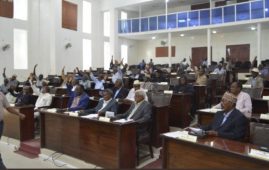Ethiopia launched ‘Climate Resilient Green Economy (CRGE)’ economic strategy plan, estimated at $ 150 Billion, to achieve green economy growth in the next two decades.
UNDP (United Nations Development Program) website reported on Friday:
Going Green: Ethiopia launches its strategy for Climate Resilient Green Economy
Ethiopia today launched its Climate Resilient Green Economy (CRGE), ahead of the 17th Conference of Parties to the UN Framework Convention on Climate Change (COP17), which will take place in Durban, South Africa from 28 November – 9 December 2011.
The green economy strategy is anchored in Ethiopia’s ambition to become a low carbon middle income economy by 2025. The third most populous African nation, Ethiopia has in recent years recorded the second fastest non-oil based growing economy in the world.
To sustain the growth, the country recently set into motion its national development strategy, the Growth and Transformation Plan (GTP), which sets forth highly ambitious targets for the country in the coming five years. The 2011-2015 GTP is the first of a three five-year-strategies designed to lead the country towards reaching middle-income status by 2025. The green economy strategy will impact at least two-thirds of Ethiopia’s economy. It is expected to help the country curb the rise in green house emissions as the country accelerates its growth rate over the coming years by providing a focus on renewable and efficient sources of energy and clean productions process in both agriculture and industry, while also enhancing and managing its forests sustainably.
Ethiopia has identified over 60 Green Economy initiatives that are expected to help ensure that the country’s greenhouse gas emission levels in 2030 do not exceed the current 150 megatonnes of CO2 equivalent. This means the country would avoid about 250 megatonne CO2 equivalent that would have been emitted had Ethiopia continued its growth on a conventional development path.
The estimated expenditure necessary to implement the Green Economy measures is around USD 150 billion over the next 20 years, a substantial proportion of which may be covered by mainstreaming the Green Economy initiatives into existing development programmes, together with international climate finance for which Ethiopia is also establishing a national Facility that meets international fiduciary standards.
The planning for the Ethiopia’s Climate Resilient Green Economy strategy was led by the Prime Minister’s office together with the country’s Environmental Protection Authority (EPA) and the Ministry of Finance and Economic Development (MoFED) and developed by government officials drawn from various relevant ministries organized into sectoral teams. By the side of the government, development partners, such as UNDP, the Global Green Growth Institute, and DFID had supported the provision of technical as well as financial support to the process. UNDP’s support to Ethiopia’s green economy strategy has been underpinned by its sustainable human development approach to the attainment of the MDGs, five of which the country is on target to achieve, and advocacy for an inclusive and sustainable growth.
In parallel with the Green Economy as a strategy for reducing the rate of climate change, the Ethiopian government has started to develop its Climate Resilience strategy, which will reduce the country’s vulnerability to extreme climate events such as droughts, floods and vector-born diseases, which are expected to intensify as the world’s climate changes, owing to already accumulated as well as anticipated global greenhouse gas emissions.
The news by the Ethiopian News Agency (ENA) reads:
Ethiopia Launches Strategy on its Green Economic Growth
The government of Ethiopia launched here on Friday its strategy to deliver green economic growth for the country.
The plan named ‘Climate Resilient Green Economy (CRGE)’ is released just weeks before the UN Framework Convention on Climate Change’s Conference of Parties (COP17) takes place in Durban, South Africa.
It sets out how the government’s dual objectives of lifting Ethiopia to middle income status by 2025 can be achieved while keeping greenhouses gas emissions constant, and marks an important milestone on Ethiopia’s path towards sustainable development.
Dr. Tewldeberhan Gebreegziabher, Director General of the Ethiopian Environment Protection Authority, said Ethiopia like any other nation, has to take measures to adapt the inevitable reality of climate change.
‘But we are going much further than that we are demonstrating that we can deliver that also effectively addresses climate change and the first step towards making our vision of a Climate Resilient Green Economy a reality, and thereby protecting and advancing the welfare of the people.’
He said the plan will affect up to two-thirds of the economy and is based on four key pillars.
Improving crop and livestock production practices for higher food security and farmer income at reduced emissions, protecting and re-growing forests to make use of their economic and ecosystem service, including their capacity to store carbon are among the impact.
Expanding electricity generation capacity from renewable sources of energy for domestic and regional markets, leapfrogging to modern and energy-efficient technologies in transport, industrial sectors and buildings included in the effects.
According to Director, 150 billion US dollars is needed to achieve these goals over the coming 15 years.
He said the finance is expected to be secured from the fund to be allocated to the green development program and from the international climate finance.
Economic Advisor of the Prime Minister, Neway Gebreab on his part said a concerted effort from the government, civic society, scholars and the public is needed to realize the green economic growth.
On the other hand, Businessweek reported:
Ethiopia Plans $150 Billion in Spending Including Carbon Cuts
Ethiopia is planning to spend $150 billion over two decades on economic development, including investments to lower the country’s carbon emissions, according to a government document.
“There is a convergence of what the economy needs in terms of growth and what is also best for ensuring that we have an economy that is resilient to climate change,” said Newai Gebre- ab, economic adviser to Prime Minister Meles Zenawi.
The Horn of Africa nation plans to keep its carbon-dioxide emissions at 150 million metric tons by 2030, the same as its current rate, according to the government’s Green Economy Strategy document. Without the green investments, the rate would be 400 million tons, it said. The savings may be worth as much as $3.6 billion a year by 2030 in carbon-trading credits partly based on prices for the European Union’s emissions permits, according to the document.
Initial plans to reduce emissions include changing farming methods, planting trees to halt deforestation, and introducing fuel-efficient stoves for cooking, according to the document.
“We will shift from using animal power for agricultural work towards mechanized power,” said Newai, who heads the committee that prepared the strategy document.
Ethiopia needs an additional $1 billion per year over the same period develop its hydroelectricity-dominated power industry, the document showed. Funds will come from increasing electricity prices and foreign sources such as businesses and sovereign-wealth funds.
*************
Check the Environment archive for previous and forthcoming posts.
Check the the drop-down menu at the top of this page for related news and analysis.





